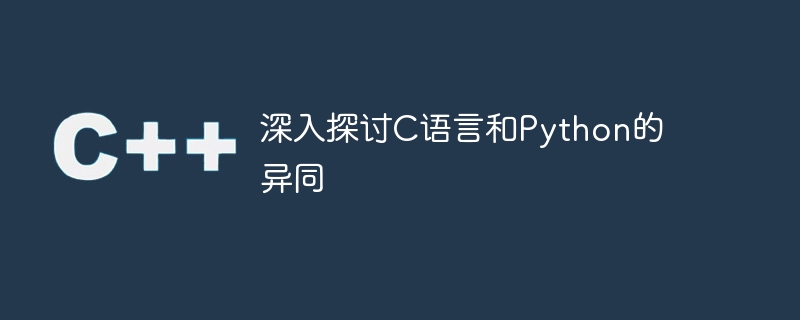
C语言和Python是两种非常流行的编程语言,它们在各自的领域具有独特的优势。本文将深入探讨C语言和Python之间的异同,并通过具体的代码示例进行比较。
首先,让我们看一下C语言和Python的语法和结构之间的差异。
#include <stdio.h>
int main() {
int a = 10;
int b = 20;
int sum = a + b;
printf("The sum of a and b is: %d
", sum);
return 0;
}a = 10
b = 20
sum = a + b
print("The sum of a and b is:", sum)可以看到,C语言需要使用#include <stdio.h>导入头文件,并且需要在main函数中明确定义返回类型。而Python则不需要显式定义变量类型,也不需要使用分号作为语句结束符。
在C语言中,需要明确定义变量的数据类型,例如int、float、char等,而Python则是一种动态类型语言,不需要显式定义变量类型。
立即学习“Python免费学习笔记(深入)”;
int number = 10; float pi = 3.14; char letter = 'A';
number = 10 pi = 3.14 letter = 'A'
另外,Python内置了许多方便的数据结构,如列表(list)、字典(dict)和集合(set),而在C语言中需要手动实现这些数据结构。
在C语言中,函数定义需要在调用之前声明,而Python则无需提前声明函数。
#include <stdio.h>
int add(int a, int b);
int main() {
int sum = add(10, 20);
printf("The sum is: %d
", sum);
return 0;
}
int add(int a, int b) {
return a + b;
}def add(a, b):
return a + b
sum = add(10, 20)
print("The sum is:", sum)在循环和条件语句方面,C语言使用大括号 {} 来定义代码块,而Python使用缩进来表示代码的层次结构。
#include <stdio.h>
int main() {
int i;
for(i = 1; i <= 5; i++) {
if(i % 2 == 0) {
printf("%d is even
", i);
} else {
printf("%d is odd
", i);
}
}
return 0;
}for i in range(1, 6):
if i % 2 == 0:
print(i, "is even")
else:
print(i, "is odd")在Python中,异常处理是一种非常重要的机制,而在C语言中则需要通过错误码或者errno来处理错误。
#include <stdio.h>
#include <errno.h>
int main() {
FILE *file = fopen("non_existent_file.txt", "r");
if(file == NULL) {
perror("Error");
return errno;
}
fclose(file);
return 0;
}try:
file = open("non_existent_file.txt", "r")
except FileNotFoundError:
print("File not found")
else:
file.close()综上所述,C语言和Python在语法、数据类型、函数定义和异常处理等方面有着明显的差异。C语言更加底层,适合对性能要求较高的场景,而Python则更加高级、灵活,适合快速开发和原型验证。选择使用哪种语言取决于具体的需求和场景。希望本文的比较能够对读者更好地理解C语言和Python的异同之处。
以上就是深入探讨C语言和Python的异同的详细内容,更多请关注php中文网其它相关文章!

C语言怎么学习?C语言怎么入门?C语言在哪学?C语言怎么学才快?不用担心,这里为大家提供了C语言速学教程(入门到精通),有需要的小伙伴保存下载就能学习啦!

Copyright 2014-2025 https://www.php.cn/ All Rights Reserved | php.cn | 湘ICP备2023035733号